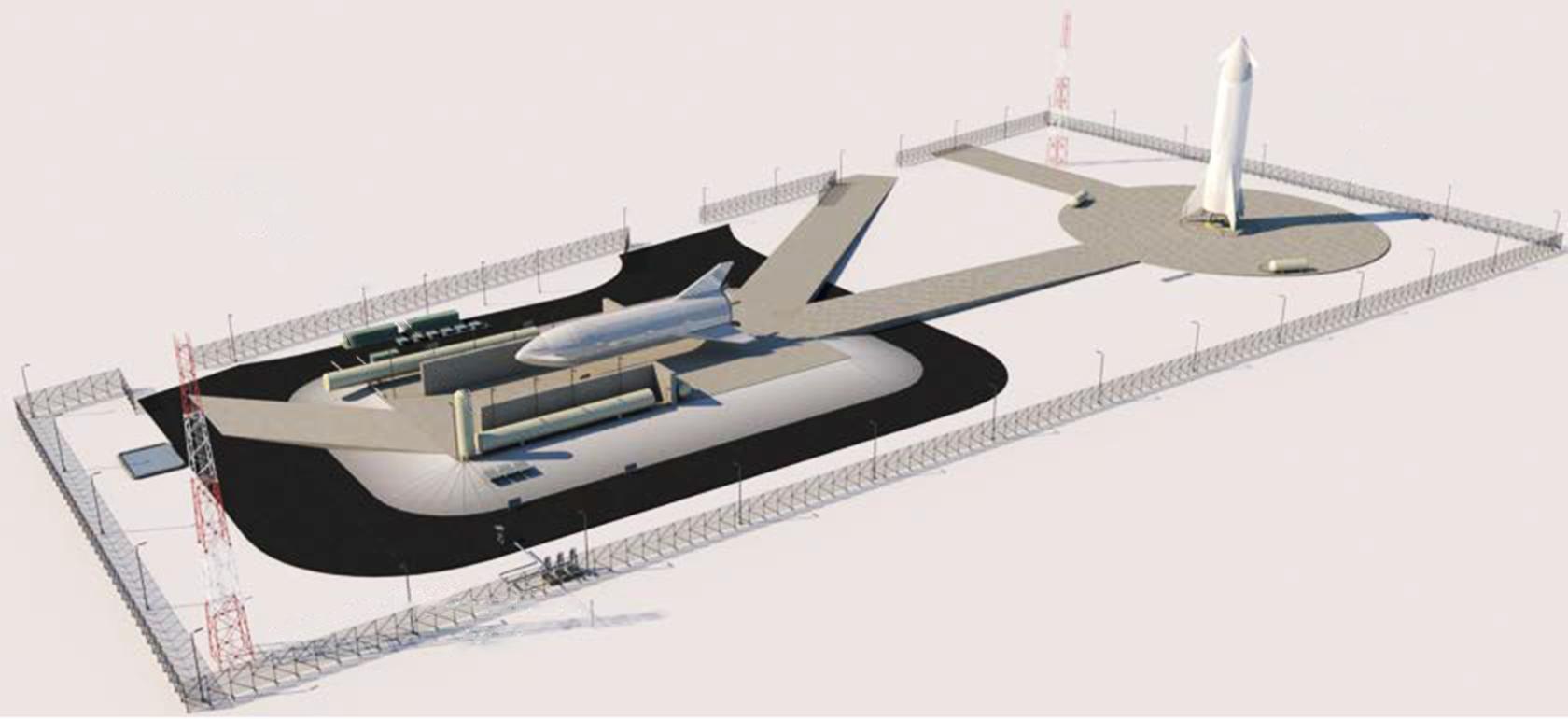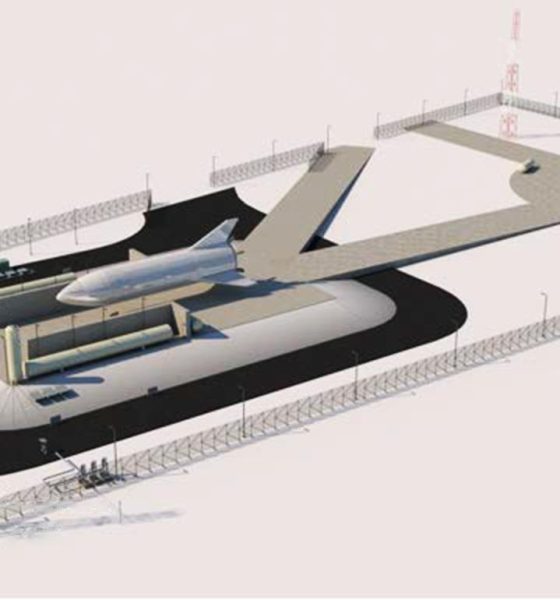

News
SpaceX files Starship flight debut paperwork, preps for launch pad upgrades
On September 9th, the first signs of SpaceX planning for Starship Mk1’s South Texas launch debut appeared in the form of FCC applications, requesting permission to communicate with the rocket prototype during its first flight.
Simultaneously, word broke on September 5th – via a Business Insider report – that SpaceX is effectively set to receive FAA permission to upgrade its South Texas launch facilities for Starship. All things considered, it appears that most – if not all – the stars have begun to align for SpaceX’s inaugural Starship launch, said by CEO Elon Musk to be scheduled for no earlier than October 2019.
The application confirms several details about Starship Mk1’s debut, revealing that SpaceX will kick off the test campaign with a running jump from Starhopper’s 150m (500 ft) flight-test hand-off. The company is targeting an altitude of ~20 km (12.5 mi) – more than two magnitudes higher than its predecessor’s peak – and plans to land the spacecraft just a hundred or so feet from its launch site, on the same landing pad used by Starhopper.
SpaceX teams continue to work around the clock to ready Starship Mk1 for its ambitious flight debut. A new ring segment was stacked on top of the vehicle’s tank section several days ago, while locals also spotted the delivery of one or two new legs/fins, built out of riveted steel. SpaceX’s Boca Chica team continues to struggle to attach Starship’s tip to the rest of its curved nose section, having recently separated the segments for the first time in months.
Preliminary welding of Starship Mk1’s upper (and final) tank dome appears to be complete and technicians are working to integrate the spacecraft’s internal hardware before it can be installed. Meanwhile, a range of new concrete pads have been set and are being outfitted with additional production hardware, likely paving the way for simultaneously Starship-Starship or Starship-Super Heavy builds in the near future.
Documents acquired and published on September 5th by Business Insider reporter Dave Mosher touched on the assembly facility’s expansion and provided an excellent overview of SpaceX’s planned upgrades to its Starship launch pad. Retasked from original plans (and approvals) for an additional Falcon 9/Falcon Heavy launch site, the documents confirmed that the FAA has reevaluated its 2014 Environmental Impact Statement (EIS) and is effectively ready to re-permit SpaceX’s Boca Chica facilities in light of its new purpose.
About as classically SpaceX as it gets, the company has already dramatically altered plans and timelines since the FAA even began to reevaluate its launch pad EIS. Discussed as Phases 1-3, SpaceX – barely two months after the FAA’s updated EIS statement – appears to have already completed Phases 1 and 2 (wet dress rehearsals, static fires, and small hops) and doesn’t have public plans for “medium hops” of “30 cm…up to 3 km”. The FAA statement – signed in May 2019 – says that the agency did not have the information necessary to permit Phase 3, involving “engine ignition and thrust to lift the Starship to 100 km, flip the Starship at high altitude, and conduct a reentry and landing.“

This article’s feature photo shows SpaceX’s late-2018/early-2019 imagining of launch site upgrades reportedly needed to support Phase 2 testing. Although extremely similar to what SpaceX has already built in South Texas, some significant changes are definitely present, and it looks like SpaceX has a busy 4-8 weeks of work ahead to complete necessary modifications, including expanded propellant storage, two large walls, and possible underground routing of critical infrastructure.
Ultimately, significant work remains for SpaceX to receive both FAA’s EIS go-ahead and experimental launch permits for Starship Mk1’s first flight. Based on the ~3 weeks it took the FAA to simply extend Starhopper’s existing 25m hop permit to 200m (eventually cut to 150m), it could be quite the uphill battle to jump to a 20 km flight test. For the time being, SpaceX hopes to conduct Starship’s 20-km flight debut as early as October 13th, in line with Musk’s ambitious “October” target.
Check out Teslarati’s Marketplace! We offer Tesla accessories, including for the Tesla Cybertruck and Tesla Model 3.

Elon Musk
Elon Musk’s X will start using a Tesla-like software update strategy
The initiative seems designed to accelerate updates to the social media platform, while maintaining maximum transparency.

Elon Musk’s social media platform X will adopt a Tesla-esque approach to software updates for its algorithm.
The initiative seems designed to accelerate updates to the social media platform, while maintaining maximum transparency.
X’s updates to its updates
As per Musk in a post on X, the social media company will be making a new algorithm to determine what organic and advertising posts are recommended to users. These updates would then be repeated every four weeks.
“We will make the new 𝕏 algorithm, including all code used to determine what organic and advertising posts are recommended to users, open source in 7 days. This will be repeated every 4 weeks, with comprehensive developer notes, to help you understand what changed,” Musk wrote in his post.
The initiative somewhat mirrors Tesla’s over-the-air update model, where vehicle software is regularly refined and pushed to users with detailed release notes. This should allow users to better understand the details of X’s every update and foster a healthy feedback loop for the social media platform.
xAI and X
X, formerly Twitter, has been acquired by Elon Musk’s artificial intelligence startup, xAI last year. Since then, xAI has seen a rapid rise in valuation. Following the company’s the company’s upsized $20 billion Series E funding round, estimates now suggest that xAI is worth tens about $230 to $235 billion. That’s several times larger than Tesla when Elon Musk received his controversial 2018 CEO Performance Award.
As per xAI, the Series E funding round attracted a diverse group of investors, including Valor Equity Partners, Stepstone Group, Fidelity Management & Research Company, Qatar Investment Authority, MGX, and Baron Capital Group, among others. Strategic partners NVIDIA and Cisco Investments also continued support for building the world’s largest GPU clusters.
News
Tesla FSD Supervised wins MotorTrend’s Best Driver Assistance Award
The decision marks a notable reversal for the publication from prior years, with judges citing major real-world improvements that pushed Tesla’s latest FSD software ahead of every competing ADAS system.

Tesla’s Full Self-Driving (Supervised) system has been named the best driver-assistance technology on the market, earning top honors at the 2026 MotorTrend Best Tech Awards.
The decision marks a notable reversal for the publication from prior years, with judges citing major real-world improvements that pushed Tesla’s latest FSD software ahead of every competing ADAS system. And it wasn’t even close.
MotorTrend reverses course
MotorTrend awarded Tesla FSD (Supervised) its 2026 Best Tech Driver Assistance title after extensive testing of the latest v14 software. The publication acknowledged that it had previously criticized earlier versions of FSD for erratic behavior and near-miss incidents, ultimately favoring rivals such as GM’s Super Cruise in earlier evaluations.
According to MotorTrend, the newest iteration of FSD resolved many of those shortcomings. Testers said v14 showed far smoother behavior in complex urban scenarios, including unprotected left turns, traffic circles, emergency vehicles, and dense city streets. While the system still requires constant driver supervision, judges concluded that no other advanced driver-assistance system currently matches its breadth of capability.
Unlike rival systems that rely on combinations of cameras, radar, lidar, and mapped highways, Tesla’s FSD operates using a camera-only approach and is capable of driving on city streets, rural roads, and freeways. MotorTrend stated that pure utility, the ability to handle nearly all road types, ultimately separated FSD from competitors like Ford BlueCruise, GM Super Cruise, and BMW’s Highway Assistant.
High cost and high capability
MotorTrend also addressed FSD’s pricing, which remains significantly higher than rival systems. Tesla currently charges $8,000 for a one-time purchase or $99 per month for a subscription, compared with far lower upfront and subscription costs from other automakers. The publication noted that the premium is justified given FSD’s unmatched scope and continuous software evolution.
Safety remained a central focus of the evaluation. While testers reported collision-free operation over thousands of miles, they noted ongoing concerns around FSD’s configurable driving modes, including options that allow aggressive driving and speeds beyond posted limits. MotorTrend emphasized that, like all Level 2 systems, FSD still depends on a fully attentive human driver at all times.
Despite those caveats, the publication concluded that Tesla’s rapid software progress fundamentally reshaped the competitive landscape. For drivers seeking the most capable hands-on driver-assistance system available today, MotorTrend concluded Tesla FSD (Supervised) now stands alone at the top.
News
Elon Musk’s Grokipedia surges to 5.6M articles, almost 79% of English Wikipedia
The explosive growth marks a major milestone for the AI-powered online encyclopedia, which was launched by Elon Musk’s xAI just months ago.

Elon Musk’s Grokipedia has grown to an impressive 5,615,201 articles as of today, closing in on 79% of the English Wikipedia’s current total of 7,119,376 articles.
The explosive growth marks a major milestone for the AI-powered online encyclopedia, which was launched by Elon Musk’s xAI just months ago. Needless to say, it would only be a matter of time before Grokipedia exceeds English Wikipedia in sheer volume.
Grokipedia’s rapid growth
xAI’s vision for Grokipedia emphasizes neutrality, while Grok’s reasoning capabilities allow for fast drafting and fact-checking. When Elon Musk announced the initiative in late September 2025, he noted that Grokipedia would be an improvement to Wikipedia because it would be designed to avoid bias.
At the time, Musk noted that Grokipedia “is a necessary step towards the xAI goal of understanding the Universe.”
Grokipedia was launched in late October, and while xAI was careful to list it only as Version 0.1 at the time, the online encyclopedia immediately earned praise. Wikipedia co-founder Larry Sanger highlighted the project’s innovative approach, noting how it leverages AI to fill knowledge gaps and enable rapid updates. Netizens also observed how Grokipedia tends to present articles in a more objective manner compared to Wikipedia, which is edited by humans.
Elon Musk’s ambitious plans
With 5,615,201 total articles, Grokipedia has now grown to almost 79% of English Wikipedia’s article base. This is incredibly quick, though Grokipedia remains text-only for now. xAI, for its part, has now updated the online encyclopedia’s iteration to v0.2.
Elon Musk has shared bold ideas for Grokipedia, including sending a record of the entire knowledge base to space as part of xAI’s mission to preserve and expand human understanding. At some point, Musk stated that Grokipedia will be renamed to Encyclopedia Galactica, and it will be sent to the cosmos.
“When Grokipedia is good enough (long way to go), we will change the name to Encyclopedia Galactica. It will be an open source distillation of all knowledge, including audio, images and video. Join xAI to help build the sci-fi version of the Library of Alexandria!” Musk wrote, adding in a later post that “Copies will be etched in stone and sent to the Moon, Mars and beyond. This time, it will not be lost.”








